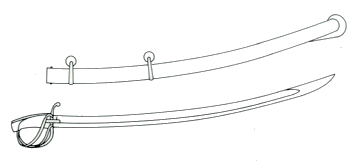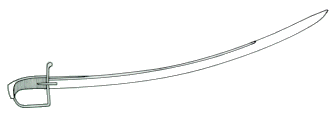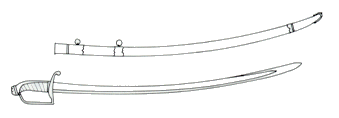





Danish weapons of 1813
During the Napoleonic wars the weapon doctrine changed the way an army would be armed and equipped. New weapons were invented and more precise firearms were produced as a result. This also happened in Denmark, although the Danes were slow to adjust to the new tactical doctrines and the new production methods. As Denmark was slow in adjusting to new doctrines quite a number of old weapons were modified to meet the changing demands of the army.
The production of firearms and other weapons for the army had until 1800 taken place at Kronborgs Geværfabrik ("Kronborgs Riflefactory"). Due to the ever rising threat of armed conflict the production of weapons was increased to meet forthcoming demands. The production of close-quater weapons (swords, sabres, lances and so forth) was transferred to Frederiksværk, which meant that Kronborg Geværfabrik would limit its production to firearms only. The factory at Frederiksværk was named Kniv- og Sabelfabrikken ("the Knife and Sabrefactory"). The two factories supplies the Danish army in its campaigns from 1807-1814.
Due to the modification policy of the Danish army (all firearms in stock was to be used, which meant that several had to be modified) the Danish army never really adopted a standard musket. In principle the muskets used by the infantry were all of the same model, but almost all of them had been modified from older models into a more modern weapon.
Infantry Musket M 1774

TOTAL LENGTH: 1.44 meters |
BARREL LENGTH: 1.05 meters |
CALIBER: 18mm |
WEIGHT: 4.86 kg |
AMOUNT PRODUCED: 56.070 |
The M 1774 smoothbore muket was the standard musket for the infantry companies and grenadier companies of the line battalions. Several modified versions of the M 1774 existed (the M1785 / M1789 / M1791 / M1794 / M1807). The modified M 1774 was widely used instead of the original musket. A M 1774 musket could be operated by a trained soldier to fire 3 aimed shots per minute. Light companies used the Light Infantry Rifle M 1807.
Skarpskyttegevær M 1789

TOTAL LENGTH: 1.41 meters |
BARREL LENGTH: 1.02 meters |
CALIBER: 19.1mm |
WEIGHT: 4.30 kg |
AMOUNT PRODUCED: app. 3.000 |
The light infantry used a modified version of the M 1774 called Skarpskyttegevær M 1789 (Sharpshooterrifle M 1789). The reason for this was the Light Infantry Rifle M 1807 (which was used by the light companies of the line battalions) had a slow rate of fire compared to the 3 shots a minute for the M 1774. The Skarpskyttegevær M 1789 was therefore used in the light battalions as it had a higher rate of fire that the M 1807 Rifle. A trained marksman could fire 1 aimed shot a minute with the M 1789. Note the sharpened ramrod which was used as a bayonet.
Cavalry Carbine M 1807

TOTAL LENGTH: 0.90 meters |
BARREL LENGTH: 0.52 meters |
CALIBER: 17.5mm |
WEIGHT: 2.48 kg |
AMOUNT PRODUCED: unknow |
The short cavalry carbine was carried by all Danish cavalry regiments in the 1813 campaign. A modified version existed, the Rifled Dragoon Carbine M 1789. The Carbine was designed for use both on horseback but also while skirmishing on foot.
Rifled Dragoon Carbine M 1789

TOTAL LENGTH: 0.90 meters |
BARREL LENGTH: 0.52 meters |
CALIBER: 16.6mm |
WEIGHT: 2.71 kg |
AMOUNT PRODUCED: 400 |
The Rifled Dragoon Carbine M 1789 was carried by the flanquers in the heavy cavalry regiments. They also carried 2 pistols and a Pallask.
Light Infantry Rifle M 1807

TOTAL LENGTH: 1.13 meters |
BARREL LENGTH: 0.73 meters |
CALIBER: 16mm |
WEIGHT: 4,05 kg |
AMOUNT PRODUCED: app. 2.000 |
Used by the light companies of the line battalions, unlike the light battalions which used the Skarpskyttegevær M 1789. The M 1807 rifle was a highly precise weapon with a slow rate of fire. Loading aming and firering a shot could take several minutes.
Cavalry Pistol M 1807

TOTAL LENGTH: 0.45 meters |
BARREL LENGTH: 0.27 meters |
CALIBER: 18mm |
WEIGHT: 1.33 kg |
AMOUNT PRODUCED: app. 3.000 |
All Danish horsemen carried 2 pistols, which was used primarely in close combat. Most horsemen carried their pistols in sheaths on their left, which made them fast and easy to draw in melee. The pistol had a very limited range. It´s handle could be used as a club.
Dragoon Sabre M 1808

TOTAL LENGTH: 1.01 meters |
BLADE LENGHT/WIDTH: 0.86 meters/3.5 cm |
HANDLE MATERIAL: Leather |
SHEATH: Iron |
SHEATH FITTINGS: 2 Carrying Rings |
The Light Dragoon regiments used the Dragoon Sabre M 1808. Besides the sabre the horsemen would carry a carbine and two pistols.
Hussar Sabre M 1808

TOTAL LENGTH: 1.01 meters |
BLADE LENGHT/WIDTH: 0.86 meters/3.6 cm |
HANDLE MATERIAL: Leather |
SHEATH: Iron and wood |
SHEATH FITTINGS: 2 Carrying Rings |
The Hussar Sabre M 1808 was carried by the Hussar Regiment along with a carbine and 2 pistols.
Cavalry Sword Pallask M 1797

TOTAL LENGTH: 1.12 meters |
BLADE LENGHT/WIDTH: 0.94 meters/3.0 cm |
HANDLE MATERIAL: Leather |
SHEATH: Iron and wood |
SHEATH FITTINGS: 2 Carrying Rings |
The Pallask M 1797 was used by the heavy Danish cavalry. The was Livregiment Ryttere, Sjællandske Rytter Regiment, Slesvigske Rytter Regiment and the Holstenske Rytter Regiment. Besides the heavy sword the horsemen also carried 2 pistols and a carbine.

TOTAL LENGTH: 0.76 meters |
BLADE LENGHT/WIDTH: 0.60 meters/3.1 cm |
HANDLE MATERIAL: Brass |
SHEATH: Brown leather |
SHEATH FITTINGS: Brass |
Carried by the grenadier companies of the line battalions, and sometimes also used by the line companies of the infantry battalions.
Light Infantry Sword Hirschfänger M 1801

TOTAL LENGTH: 0.76 meters |
BLADE LENGHT/WIDTH: 0.63 meters/3.6 cm |
HANDLE MATERIAL: Brass |
SHEATH: Brown leather |
SHEATH FITTINGS: Brass |
The Hirschfänger M 1801 was used by the light companies of the line battalions along with their Light Infantry Rifle M 1807. It could function both as a sword and a bayonet.
Horse Artillery Sabre M 1808

TOTAL LENGTH: 0.95 meters |
BLADE LENGHT/WIDTH: 0.80 meters/3.5 cm |
HANDLE MATERIAL: Leather |
SHEATH: Black leather |
SHEATH FITTINGS: Brass |
Carried by the privates of the mounted artillery.
Officer Sabre M 1789

TOTAL LENGTH: 0.89 meters |
BLADE LENGHT/WIDTH: 0.76 meters/3 cm |
HANDLE MATERIAL: Leather |
SHEATH: Black |
SHEATH FITTINGS: Brass, 2 Carrying Rings |
The Infantry officers used the Officer Sabre M 1789. Several variants may exist. The artillery and cavalry officers used a modified version of their regiments sabres.